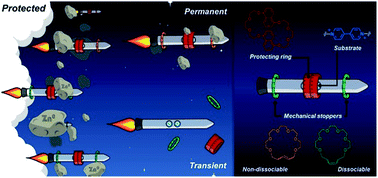Programming permanent and transient molecular protection via mechanical stoppering†
Abstract
Chemical protection is an essential tool in synthetic chemistry, which involves blocking reactive sites on a molecule through covalent bonds. Physical approaches, such as encapsulation and host-mediated protection, have emerged as interesting alternatives that use steric bulk to inhibit reactivity. Here, we report the protection of a redox-active viologen through its incorporation into mechanically interlocked molecules (MIMs), namely hetero[4]rotaxanes. The viologen was confined inside a host cavity and flanked by two mechanical stoppers, which allowed for permanent and transient protection. Deprotection occurred on-demand via an unstoppering process, triggered by a proton transfer, polarity effect, or a thermal stimulus. We anticipate that permanent and transient mechanical stoppering could be incorporated into devices to function as molecular probes, transport/delivery systems, or stimuli-controlled degradable materials.



 Please wait while we load your content...
Please wait while we load your content...